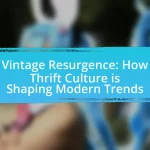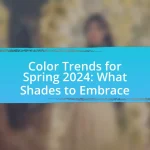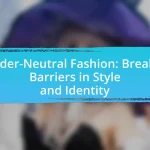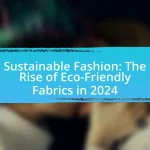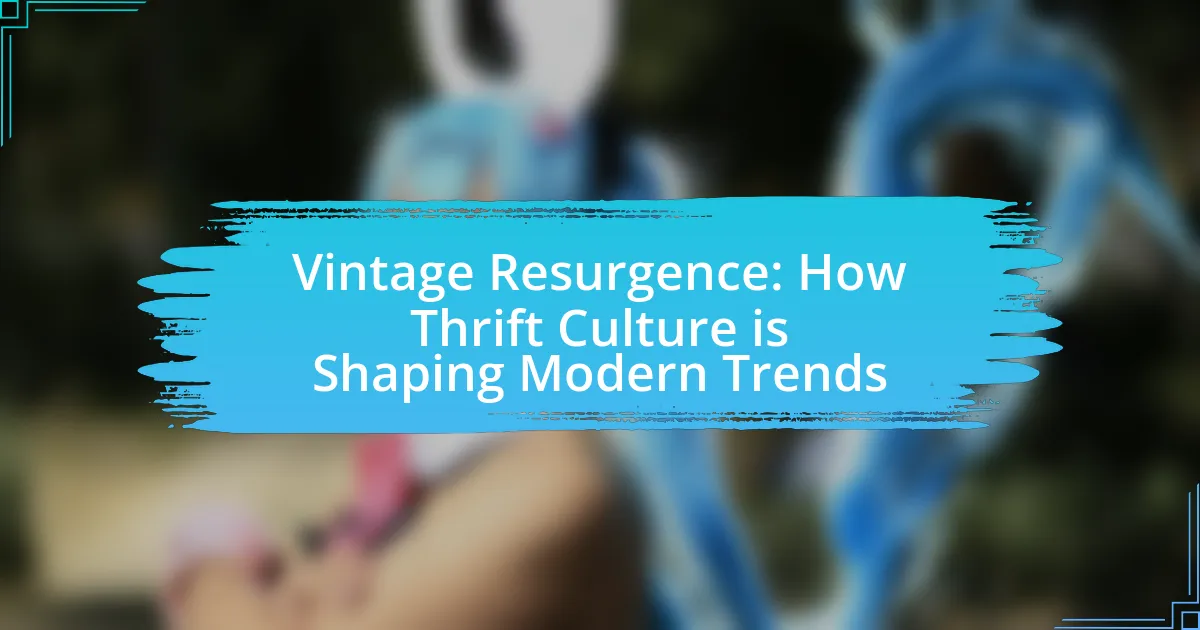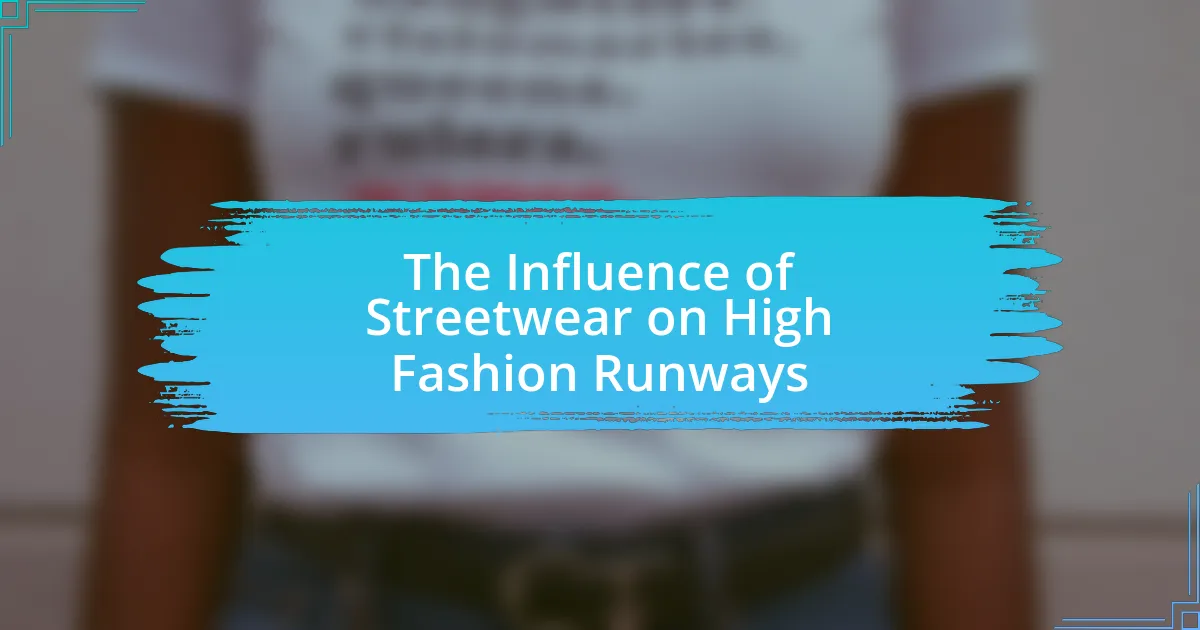The article examines the significant impact of social media on the emergence and dissemination of micro-trends in fashion. It highlights how platforms like Instagram and TikTok facilitate rapid sharing of niche styles, influencing consumer behavior and purchasing decisions. The role of influencers in shaping these trends is emphasized, along with the effects of algorithms on visibility. Additionally, the article discusses the characteristics of micro-trends compared to traditional trends, their implications for consumer behavior, and the challenges associated with sustainability and authenticity in the fast-paced fashion landscape.
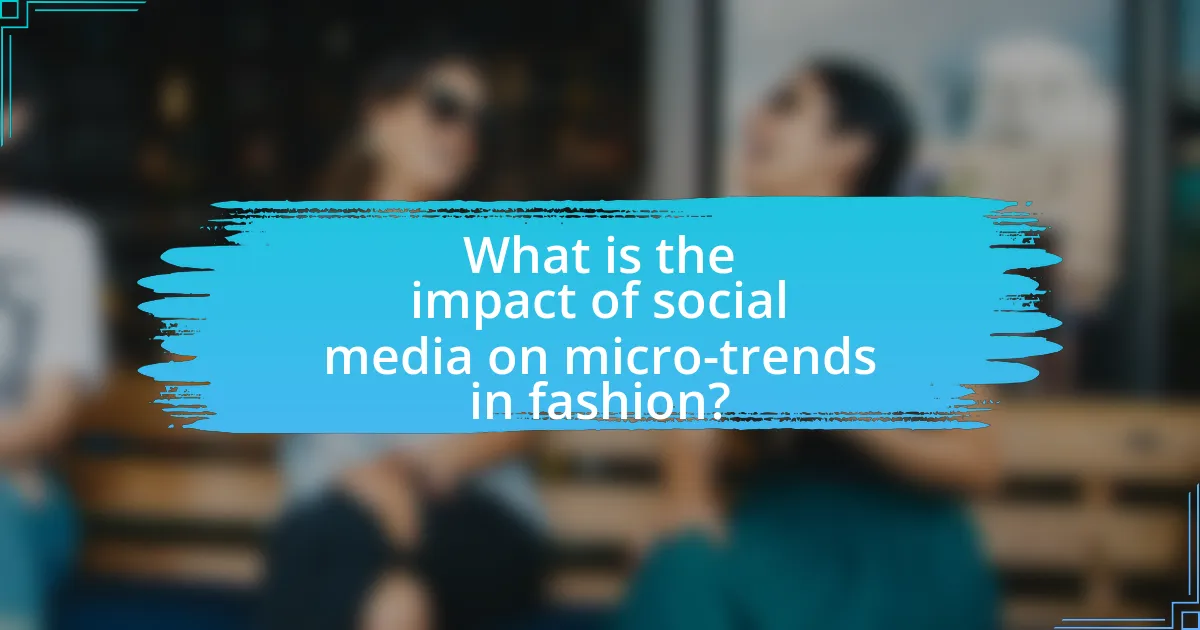
What is the impact of social media on micro-trends in fashion?
Social media significantly accelerates the emergence and dissemination of micro-trends in fashion. Platforms like Instagram and TikTok enable rapid sharing of styles, allowing influencers and users to showcase niche fashion items that can quickly gain popularity. For instance, a study by the Journal of Fashion Marketing and Management found that 70% of consumers are influenced by social media when making fashion purchases, highlighting the platform’s role in shaping consumer behavior. This immediacy and reach facilitate micro-trends, which often reflect current cultural moments or seasonal shifts, leading to a dynamic and ever-changing fashion landscape.
How does social media influence the emergence of micro-trends?
Social media significantly influences the emergence of micro-trends by facilitating rapid information dissemination and fostering community engagement. Platforms like Instagram and TikTok allow users to share and promote niche fashion styles, leading to quick adoption and visibility among target audiences. For instance, a study by the Pew Research Center found that 72% of teens use Instagram, making it a powerful tool for trend propagation. This high engagement rate enables micro-trends to gain traction swiftly, as users often replicate styles seen in their feeds, creating a cycle of influence that can lead to widespread popularity in a short time frame.
What role do influencers play in shaping micro-trends through social media?
Influencers play a crucial role in shaping micro-trends through social media by leveraging their reach and credibility to introduce and popularize niche styles and products. Their ability to create engaging content allows them to connect with specific audiences, often leading to rapid adoption of new trends. For instance, a study by the Digital Marketing Institute found that 49% of consumers depend on influencer recommendations for their purchasing decisions, highlighting the significant impact influencers have on consumer behavior and trend formation. This dynamic enables influencers to not only reflect existing trends but also to initiate and drive new ones within the fashion industry.
How do algorithms affect the visibility of micro-trends on social media platforms?
Algorithms significantly influence the visibility of micro-trends on social media platforms by determining which content is prioritized in users’ feeds. These algorithms analyze user behavior, engagement metrics, and content relevance to curate personalized experiences, thereby amplifying certain trends while suppressing others. For instance, platforms like Instagram and TikTok utilize machine learning algorithms that favor posts with higher engagement rates, leading to a snowball effect where popular micro-trends gain more visibility. Research indicates that content that resonates with a specific audience can achieve virality, as seen in the rise of niche fashion trends that emerge from targeted communities. This mechanism ensures that micro-trends can rapidly gain traction or fade away based on algorithmic preferences, shaping the overall landscape of fashion trends on social media.
Why are micro-trends significant in the fashion industry?
Micro-trends are significant in the fashion industry because they reflect rapidly changing consumer preferences and behaviors, often driven by social media. These trends allow brands to quickly adapt their offerings to meet the evolving tastes of their target audience, enhancing customer engagement and sales. For instance, a study by WGSN found that micro-trends can emerge and fade within weeks, highlighting the need for brands to stay agile and responsive. This responsiveness not only helps in capturing market share but also fosters brand loyalty among consumers who seek the latest styles.
What are the characteristics of micro-trends compared to traditional fashion trends?
Micro-trends are characterized by their rapid emergence and short lifespan, contrasting with traditional fashion trends, which typically develop over longer periods and maintain a more stable presence. Micro-trends often arise from social media platforms, where influencers and users quickly share and popularize specific styles, leading to swift adoption and equally swift decline. In contrast, traditional trends are usually established through extensive fashion cycles, often influenced by designers and fashion weeks, and can last for several seasons or years. The immediacy of micro-trends is evidenced by the speed at which they can go viral, with platforms like TikTok and Instagram facilitating trends that may only last a few weeks, whereas traditional trends are built on a foundation of cultural shifts and broader societal acceptance, often supported by marketing campaigns and retail strategies that span longer timeframes.
How do micro-trends impact consumer behavior and purchasing decisions?
Micro-trends significantly influence consumer behavior and purchasing decisions by creating a sense of urgency and exclusivity around specific products or styles. These trends often emerge rapidly through social media platforms, where influencers and peer groups showcase new fashion items, leading to increased visibility and desirability. For instance, a study by the NPD Group found that 70% of consumers are influenced by social media when making fashion purchases, highlighting the direct correlation between micro-trends and buying behavior. As consumers seek to align with these fleeting trends, they are more likely to make impulsive purchases, often driven by the fear of missing out (FOMO) on the latest styles. This dynamic illustrates how micro-trends can rapidly shift market demand and shape consumer preferences in the fashion industry.

How do different social media platforms contribute to micro-trends in fashion?
Different social media platforms contribute to micro-trends in fashion by facilitating rapid information sharing and community engagement. Platforms like Instagram and TikTok allow users to showcase outfits and styles, leading to viral trends that can emerge overnight. For instance, TikTok’s algorithm promotes content based on user interaction, enabling niche fashion styles to gain visibility quickly, as seen with the rise of “cottagecore” aesthetics in 2020. Additionally, Instagram’s visual-centric approach encourages influencers to curate and share fashion looks, which can lead to widespread adoption of specific trends, evidenced by the popularity of oversized blazers in 2021. These platforms create a feedback loop where trends can be quickly adopted, modified, and disseminated, significantly impacting consumer behavior and fashion choices.
What unique features of platforms like Instagram and TikTok drive micro-trend creation?
Instagram and TikTok drive micro-trend creation through their algorithm-driven content discovery, short-form video formats, and user engagement features. The algorithms prioritize trending content, allowing users to quickly discover and engage with emerging styles, which accelerates the spread of micro-trends. The short-form video format encourages creativity and rapid consumption, making it easier for users to participate in challenges or trends, thus amplifying their reach. Additionally, features like hashtags and challenges foster community participation, enabling users to contribute to and shape trends collectively. These elements create a dynamic environment where micro-trends can emerge and evolve rapidly, supported by user-generated content and viral sharing.
How does visual content on Instagram promote specific fashion micro-trends?
Visual content on Instagram promotes specific fashion micro-trends by enabling rapid dissemination and visual appeal of styles among users. The platform’s algorithm prioritizes engaging images and videos, allowing trends to gain visibility quickly as users share and interact with content. For instance, a study by the Journal of Fashion Marketing and Management found that 79% of users reported discovering new fashion trends through Instagram, highlighting its role in shaping consumer preferences. Additionally, influencers and brands leverage visually striking posts to create aspirational content, further driving the adoption of micro-trends within niche communities.
What role does TikTok’s short-form video format play in the rapid spread of micro-trends?
TikTok’s short-form video format significantly accelerates the spread of micro-trends by enabling rapid content consumption and sharing. This format allows users to create and view engaging videos that are typically 15 to 60 seconds long, making it easy for trends to gain traction quickly. The platform’s algorithm promotes content based on user engagement, which means that popular micro-trends can reach a vast audience in a short period. For instance, a fashion item featured in a viral TikTok video can lead to widespread adoption, as seen with the popularity of specific clothing styles or accessories that trend within days. This immediacy and virality are key factors in how micro-trends proliferate in the fashion industry.
How do user interactions on social media shape the evolution of micro-trends?
User interactions on social media significantly shape the evolution of micro-trends by facilitating rapid dissemination and engagement with niche content. When users like, share, or comment on specific fashion posts, they amplify visibility and create a feedback loop that encourages content creators to produce more of what resonates with their audience. For instance, a study by the Pew Research Center found that 72% of teenagers use Instagram, where visual content can quickly go viral, leading to the emergence of micro-trends based on user preferences and interactions. This dynamic allows for trends to evolve swiftly, as users continuously adapt their preferences based on real-time feedback from their social networks.
What impact do likes, shares, and comments have on the popularity of micro-trends?
Likes, shares, and comments significantly enhance the popularity of micro-trends by increasing visibility and engagement on social media platforms. When users interact with content through likes, shares, and comments, they amplify its reach, making it more likely to be seen by a broader audience. For instance, a study by the Pew Research Center found that social media engagement can lead to a 30% increase in the likelihood of a trend being adopted by others. This engagement creates a feedback loop where increased interaction leads to greater visibility, further driving the trend’s popularity.
How do community-driven trends differ from brand-driven trends on social media?
Community-driven trends on social media emerge organically from user interactions and shared interests, while brand-driven trends are initiated and promoted by companies to influence consumer behavior. Community-driven trends often reflect authentic user experiences and preferences, leading to grassroots movements that can rapidly gain traction, as seen with viral challenges or grassroots fashion movements. In contrast, brand-driven trends rely on marketing strategies, advertising campaigns, and influencer partnerships to create awareness and drive sales, exemplified by seasonal collections launched by major fashion brands. The distinction lies in the source of influence: community-driven trends prioritize user-generated content and peer recommendations, whereas brand-driven trends focus on corporate messaging and promotional efforts.

What are the challenges and criticisms associated with social media-driven micro-trends in fashion?
Social media-driven micro-trends in fashion face several challenges and criticisms, primarily related to sustainability, consumerism, and authenticity. The rapid pace of micro-trends often leads to increased waste, as brands produce low-quality, fast-fashion items that are quickly discarded, contributing to environmental degradation. According to a report by the Ellen MacArthur Foundation, the fashion industry is responsible for 10% of global carbon emissions, highlighting the ecological impact of these trends. Additionally, the constant push for new styles fosters a culture of overconsumption, where consumers feel pressured to continuously buy new items to stay relevant. This phenomenon can undermine the value of timeless fashion and promote a disposable mindset. Furthermore, the authenticity of influencers and brands is often questioned, as many promote trends for profit rather than genuine passion, leading to skepticism among consumers about the motivations behind these trends.
What negative effects can arise from the fast-paced nature of micro-trends?
The fast-paced nature of micro-trends can lead to negative effects such as increased consumerism and environmental degradation. Rapidly changing trends encourage consumers to frequently purchase new items, contributing to a throwaway culture where clothing is discarded after minimal use. According to the Ellen MacArthur Foundation, the fashion industry is responsible for 92 million tons of waste annually, much of which is driven by fast fashion and micro-trends. Additionally, the constant cycle of trends can create mental health issues, as individuals may feel pressured to keep up with ever-changing styles, leading to anxiety and dissatisfaction.
How does the rapid turnover of micro-trends contribute to fashion waste?
The rapid turnover of micro-trends significantly contributes to fashion waste by encouraging consumers to frequently purchase new items that quickly go out of style. This phenomenon is driven by social media platforms, where trends can emerge and fade within weeks, leading to a cycle of overconsumption. According to a 2021 report by the Ellen MacArthur Foundation, the fashion industry produces more than 92 million tons of waste annually, much of which is attributed to fast fashion practices fueled by these fleeting trends. As consumers discard clothing that no longer aligns with the latest micro-trends, the environmental impact intensifies, resulting in increased landfill contributions and resource depletion.
What are the implications of promoting unrealistic beauty standards through micro-trends?
Promoting unrealistic beauty standards through micro-trends leads to negative psychological effects, including body dissatisfaction and low self-esteem. Research indicates that exposure to idealized images on social media can result in increased anxiety and depression among individuals, particularly young women. A study published in the journal “Body Image” found that individuals who frequently engage with social media platforms displaying such standards are more likely to experience negative body image and disordered eating behaviors. Furthermore, these micro-trends can perpetuate a narrow definition of beauty, marginalizing diverse body types and reinforcing harmful stereotypes. This cycle not only affects individual mental health but also shapes societal norms around beauty, leading to a culture that values appearance over authenticity and well-being.
How can brands effectively navigate the landscape of micro-trends on social media?
Brands can effectively navigate the landscape of micro-trends on social media by leveraging data analytics to identify emerging patterns and consumer preferences. Utilizing tools like social listening and trend analysis, brands can monitor conversations and engagement metrics to pinpoint micro-trends that resonate with their target audience. For instance, a study by McKinsey & Company found that brands that actively engage with real-time data can increase their market responsiveness by up to 30%. By adapting their marketing strategies and product offerings in alignment with these insights, brands can enhance their relevance and connection with consumers, ultimately driving sales and brand loyalty.
What strategies can brands employ to leverage micro-trends for marketing success?
Brands can leverage micro-trends for marketing success by utilizing real-time social media analytics to identify emerging patterns and consumer preferences. By monitoring platforms like Instagram and TikTok, brands can quickly adapt their marketing strategies to align with these trends, ensuring relevance and engagement. For instance, a study by McKinsey & Company highlights that brands that respond swiftly to micro-trends can increase their market share by up to 20%. Additionally, collaborating with micro-influencers who resonate with specific niches allows brands to authentically connect with target audiences, enhancing brand loyalty and driving sales.
How can brands balance authenticity and trendiness in their social media campaigns?
Brands can balance authenticity and trendiness in their social media campaigns by integrating genuine storytelling with current trends. This approach allows brands to resonate with their audience while staying relevant. For instance, a study by the Harvard Business Review found that 64% of consumers want brands to connect with them on a personal level, emphasizing the importance of authenticity. By showcasing real customer experiences and aligning them with trending topics or styles, brands can create content that feels both timely and true to their identity. This strategy not only fosters trust but also enhances engagement, as consumers are more likely to share content that reflects their values and interests.
What best practices should consumers follow when engaging with micro-trends in fashion?
Consumers should prioritize sustainability and personal style when engaging with micro-trends in fashion. By selecting items that align with their values and wardrobe, consumers can avoid contributing to fast fashion’s negative environmental impact. Research indicates that the fashion industry is responsible for 10% of global carbon emissions, highlighting the importance of mindful consumption. Additionally, consumers should critically assess the longevity of micro-trends, opting for versatile pieces that can be integrated into their existing wardrobe. This approach not only promotes individual expression but also reduces waste, as versatile items are more likely to be worn beyond the trend’s peak.
